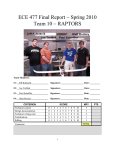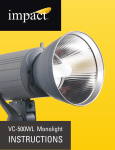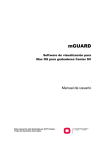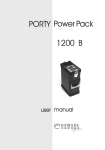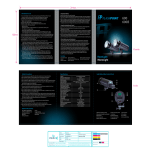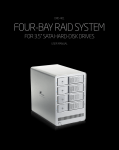Download User Manual - B&H Photo Video Digital Cameras, Photography
Transcript
SDR-400 ALPHA MONOLIGHT USER MANUAL INTRODUCTION Thank you for choosing the Raya SDR-400 Alpha Monolight. This all-in-one, fan-cooled 400w/s monolight uses intelligent technology, creating a sleek, compact, and easy to use flash unit. Constructed with a high-quality rubberized polymer housing, the SDR400 is operated with a clearly marked digital control panel, creating a simple and intuitive workflow for controlling everything from power levels in one-tenth stop increments to the built-in wireless receiver. The durable SDR-400 has an integrated four-channel wireless receiver that communicates with an included wireless transmitter. You can easily change the wireless frequency of the monolight with DIP switches. Additionally, the monolight includes five individual slave settings, ranging from a regular slave mode to modes that will trigger the unit with external flashes with up to three pre-flashes. The Raya SDR-400 Alpha Monolight is equipped with advanced protection circuit controls to prevent several types of common high-voltage electronics issues, including over-heating, over-volting, and overcharging. This Raya studio flash is ideal for photography enthusiasts looking for an economical high-powered flash unit with the convenience of wireless triggering. The unit’s auto-seeking multi-voltage (100~240V, 50/60 Hz) circuitry and compact construction make this monolight ideal for local and international use (an AC plug adapter will be necessary for use outside the U.S. as well as a 220-240V modeling lamp). FEATURES Multi-voltage 100~240VAC 50/60Hz Built-in 4-channel radio receiver for wireless function Includes 4-channel radio transmitter for wireless triggering Lightweight, compact, and easily transported Durable, high-quality, rubberized polymer housing Easy to view LED power display Intuitive operating Precision light-output adjustments of 6 f-stops from full to 1/32 in 0.1 stop increments Proportional or Independent modeling lamp control 150W 110V quartz halogen modeling lamp Quick recycle time Fast flash duration Fan-cooled Adaptive thermal control protects against overheating and overvoltage damage 4 Auto power dump feature Built-in optical slave Sync delay and red eye reduction functions Model lamp SSC (Soft Start Circuitry) Plug-in user-replaceable flashtube 7˝ umbrella/grid reflector BOX CONTENTS SDR-400 Alpha Monolight Umbrella reflector with 7˝ grid inset 4-channel wireless transmitter Protective cap AC cord - 16´ (4.9 m) Sync cord - 11´ (3.35 m) 5 OVERVIEW 12 2 1 3 4 11 5 8 7 10 9 6 1. 6 S-Mount (reflector mount) 7. Umbrella mount 2. Mount release 8. Umbrella tightening knob 3. Modeling light 9. Mount tightening knob 4. Modeling light socket 10. Tilt knob 5. Flash tube 11.Fan 6. 5/8˝ stand mount 12.Handle 20 14 13 22 19 15 16 17 18 21 23 24 13. Digital Control Pad Remote: 14. Remote sensor 20. Test button 15. AC input 21. DIP switches 16. Fuse bay 22. Shoe foot 17. Power switch 23. Tightening ring 18. Sync cable port 24. 3.5 mm port 19. DIP switches 7 PRECAUTIONS ⚠ ⚡ 8 • Please read and follow these instructions and keep this manual in a safe place. • Keep this product away from water and any flammable gases or liquids. • Make sure this product is turned off when plugging it into an electrical outlet. • Use only the correct, recommended voltage. • Do not attempt to disassemble or repair this product. There are components inside that can produce a hazardous electric shock. • Handle this product with care. • Do not stare at the lights when they are powered on. • Avoid rapid, high-power flashing. • Excessive heat shortens the life span of flash tubes, modeling lamps, and internal components. • If not used for two months, turn the unit on for 30 minutes and fire the flash several times to charge the capacitors. • Always remove the protective cap before plugging in or powering on the unit. • Never operate the flash with the protective cap on. • Clean this product with only a soft, dry cloth. • Always wear cotton gloves when handling the flashtube. • Never open or do repairs on the unit. There are no userserviceable parts. • Keep this product away from children. • Make sure everything is secure before proceeding. • Make sure that this product is intact and that there are no missing parts before use. • All photos are for illustrative purposes only. PREPARING FOR USE The Raya SDR-400 includes a user-replaceable flash tube and modeling lamp. Be careful not to touch the flash tube with your bare hands since this could cause damage to it. Please use cotton gloves or a soft, dry cloth when touching or handling the flash tube. The Raya 150W modeling lamp is a halogen bulb within a glass sleeve. You may touch this glass without cotton gloves. However, wiping it with a cotton cloth after handling it is recommended. The monolight comes with a protective cap. Always remove the protective cap before plugging in or powering on the unit. To remove the cap, hold down the mount release and turn the cap counterclockwise. Pull the cap from the mount and place it to the side for later use. 9 GENERAL OPERATION INSTRUCTIONS To begin using the monolight, do the following: NOTE: Ensure the power switch is set to OFF before connecting the monolight’s power cord. 1. Plug the cord into the AC wall outlet, then plug the connector into the AC input on the flash unit. 2. Power on the monolight by flipping the power switch located on the back of the unit. 3. Turn on the modeling light using the modeling light button. For more information about how to operate the modeling light, refer to the Setting the Modeling Light Power Output section on page 24. 4. Connect your camera to the monolight to begin triggering. CONNECTING YOUR CAMERA TO THE MONOLIGHT The Raya SDR-400 Alpha Monolight has two triggering options out of the box – wireless and sync cord connections. Please reference the following instructions to connect your camera to the monolight. 10 Wireless The Raya SDR-400 has an integrated four-channel wireless receiver. Using the included transmitter, you can wirelessly trigger your flash unit from up to 65-feet away. No line-of-sight is required for your monolight to communicate with the transmitter. Use the following instructions to set up and wirelessly trigger your flash. 1. Locate the DIP switches on the back of the monolight. 2. Set the channel frequency of your choosing. 3. On the transmitter, set the DIP switches to the same channel as on the monolight. 4. Press the test button on the transmitter to fire the monolight. Please reference the following chart for channel settings: 11 5. For wireless triggering of the monolight’s flash by pressing the camera’s shutter button, open the remote’s tightening ring by turning it clockwise. Slide the remote into your camera’s hot shoe and turn the tightening ring counterclockwise to secure. Sync Cord The back of your monolight has a 3.5 mm sync input, which is used for a hardwire connection between your camera and the flash unit. Use the following instructions to connect your two devices: 1. Insert the included 11’ sync cable’s mini-plug into the monolight’s 3.5 mm sync cable port. 2. Connect the PC connector end into your camera’s PC socket. If you camera does not have a PC port, an adapter will be required. 12 MOUNTING ACCESSORIES Light Stand Mount The SDR-400 Alpha Monolight has a standard 5/8” stand mount with tilt and tightening knobs. To mount the monolight on a light stand, place the stand mount onto a compatible stand with a standard 5/8” top mount. Tighten the tightening knob to secure. Turn the tilt knob counter clockwise to adjust the tilt of the monolight. Turn the knob clockwise to secure the monolight in place. Accessory S-Mount The Raya SDR-400 Alpha Monolight has an S-Mount for light-modifying accessories. This can be used with such optional add-ons as speed rings 13 for softboxes. The included umbrella reflector lines up with the unit’s umbrella mount located on the monolight’s stand mount. To use accessories with the monolight’s S-Mount, simply align the accessory with the mount and insert. Once inserted, rotate the accessory clockwise to secure. To remove it from the mount, hold down the mount release and reverse the above instruction. Umbrella Mount To mount an umbrella to the monolight, first attach the umbrella reflector dish using the above instructions. Then run the umbrella rod through the dish’s umbrella hole and into the monolight’s umbrella mount. Secure the umbrella using the umbrella tightening knob. 14 FLASH SETTINGS Setting the Monolight’s Power Output The Raya SDR400 Alpha Monolight’s flashtube has a 6-stop power range, represented by a 10-60 numbered scale on the LED screen. To increase the power output of the monolight, press the button on the back of the flash unit. To decrease the power output, press the button. NOTE: Each button press changes the power output by one-tenth of a unit. To increase or decrease whole numbers displayed on the screen at a faster pace, hold down the adjustment button. Setting the Modeling Light Power Output The Raya SDR400 Alpha Monolight has a 150 watt user-replaceable modeling light. The modeling light’s power output is represented by a 10-60 numbered scale on the LED screen. To increase the modeling light’s power output, press the button. To decrease the output, press the button. 15 The modeling light has two indicator lights: Proportional: When the model light is turned on, the default setting is proportional, as indicated by the bottom green light. As you adjust the monolight’s power output (using the or buttons), the modeling light will adjust up or down proportionally. This gives you the general idea where highlights and shadows will fall in relation to the flash power. Independent: To change from the default setting, press the up or down arrow once. The top green light will glow green, and the bottom green light will disappear. Blinking numbers will appear on the LED screen, displaying the current modeling light output setting. The numbers will continue to blink while adjusting the setting. Once the desired number is selected, the numbers will blink four times, then return to the solid monolight power output numbers. NOTE: Each button press changes the power output by one tenth unit. To increase or decrease the numbers displayed on the screen faster, hold down the adjustment button. 16 Auto Power Dump When lowering the power level, the monolight will automatically discharge a flash when the new setting is confirmed. Do not look into the flash tube area when performing this change. SLAVE AND PRE-FLASH SETTINGS The Raya SDR400 Alpha Monolight has five slave settings. You can toggle between the modes by repeatedly pushing the slave button until the required number is indicated by the light on the right side of the panel. Default Setting: No LED light is activated. Slave mode is OFF. Setting 1: Slave mode ON. A single flash from another source will trigger the monolight. Setting 2: The monolight will trigger after a half second delay. After the first flash from another source, the monolight will go into a standby mode, and the SDR-400 will trigger at the next flash. Setting 3: Monolight will trigger after one preflash. Setting 4: Monolight will trigger after two preflashes. Setting 5: Monolight will trigger after three preflashes. 17 BUTTON GUIDE 1. Test button a. Manually triggers the monolight at the current settings. 2. Sound control a. Turns the confirmation sounds on and off. 3. Slave button a. Activates slave mode. 4. Slave mode indicator lights a. Indicates which slave mode is activated. 5. Power output buttons a. Increases or decreases the power output of the monolight. 6. Modeling light button a. Turns the modeling light on or off. 7. Modeling light indicator light when button is pushed a. Bottom green light on modeling light button turns on – default position. 18 b. Indicates that modeling light intensity level is proportional to the flash tube. 8. Modeling light independent indicator light when ‘up’ or ‘down’ arrow button is pushed a. Top light on model light button goes on b. Indicates that the modeling light’s intensity level is independent of the flash tube’s output 9. Modeling light intensity level ‘up’ and ‘down’ arrow adjustment buttons a. Adjusts the intensity level of the modeling light b. Turns on independent model light mode and overrides proportional mode, as displayed in blinking numbers. 1 2 3 4 5 6 7 8 9 19 DIGITAL CONTROL PANEL GUIDE LED Screen Guide Steady Numbers Steady numbers indicate the monolight’s flashtube power output, as controlled by the power level buttons . Blinking Numbers Blinking numbers on the LED screen indicate the intensity levels of the modeling light during adjustment, as controlled by the modeling light output buttons . The numbers only blink when the modeling light intensity level is being adjusted. It will stop blinking after four blinks. Confirmation When the monolight’s sound is turned off and the modeling light is turned on, the modeling light will turn off after a flashtube triggering and come back on once the unit has recycled, providing a visual confirmation that the unit is ready to flash again at 100%. 20 INSTALLATION & REPLACEMENT GUIDE The Modeling Light The Raya SDR-400 comes with a 150W, 110V halogen model lamp bulb. To remove an old bulb and install a replacement bulb, do the following: 1. Ensure the monolight is powered off and unplugged. 2. Using a cotton glove or soft, dry cloth, carefully unscrew the modeling light bulb. 3. With the cotton glove or soft, dry cloth, pick up the replacement tube. 4. Insert the back end of the bulb into the modeling bulb socket and turn it clockwise until secure. NOTE: The SDR-400 has built-in SSC (Soft Start Circuitry) to ensure longer modeling lamp life. When the modeling lamp is turned on, it will light up at a 21 minimum brightness and slowly reach full power output. This feature prolongs the life of the modeling lamp. The Flash Tube The Raya SDR-400’s flash tube is user-replaceable. To replace the flash tube, do the following: 1. Discharge the flash unit by pressing the test button. 2. Power off the monolight and unplug the power cable from the flash unit and power source. 3. After 15 minutes, remove the modeling lamp and any other accessory connected to the unit. 4. Wearing a pair of cotton gloves or using a soft, dry cloth and using a pair of needle-nose pliers, carefully unhook the retention spring loop of the flash tube. Make sure it is disengaged from the flash tube. 22 5. Once it is unhooked, grip the base of the flash tube on each side and carefully pull it from the monolight. 6. Pick up the new flashtube and push its pins into the sockets using firm, even pressure at the base. 7. With needle-nose pliers, hook the retention spring over and above the flash tube. 8. Reinsert the modeling lamp, then any other accessory to the monolight. Replacing the Fuse The Raya SDR-400 comes with two fuses: one installed and one spare. Both are located within the fuse bay. To remove the fuse housing from the fuse bay and replace the fuse, do the following: 1. Ensure the monolight is powered off and unplugged. 23 2. Using a flat head screwdriver, lift the fuse housing from the nook found on the flat side of the AC jack. 3. The fuse located within the housing is the one the monolight is using when it is powered on. To replace the fuse, remove it from the box. 4. Replace it with a spare. 5. Reattach the fuse holder to the fuse bay to complete the process. MAINTENANCE NOTES Adaptive Thermal Control The Raya SDR-400 Alpha Monolight is equipped with protection circuits to prevent damage to the internal electronics from over-heating, over-volting, and over-charging. To avoid damaging the unit, please follow the 24 information outlined in the Precautions section. NOTE: The fan turns on when the unit’s internal heat reaches 122°F (50°C). Error Codes The Raya SDR-400’s LED screen will indicate one of the following codes when it detects an issue. E1 = One or more of the capacitors is overvolting. If this error occurs, turn the unit off and let it rest for a few minutes. If the error message comes up again, contact the manufacturer. E2 = The monolight is overheating (176°F, 80°C). The error will disappear once the unit has cooled. Press any button (except the power button) to remove the error message. The fan will continue to cool the unit until the heat has dissipated after 5-10 minutes. If the monolight is turned off, the light will take longer to cool. E3 = The monolight’s input voltage is more than 265 volts. If this error occurs, turn the unit off and let it rest for a few minutes. If the error message comes up again, contact the manufacturer. 25 26 Specifications SDR-400 Power Output 400 w/s Guide Number 165 (10´ @ ISO 100) Output Control Range Full to 1/32 in 1/10 increments Recycle Time 100~120V 60Hz 0.2 ~ 2.2 Sec Recycle Time 220~240V 50 Hz 0.2 ~ 1.7 Sec Flash Ready Indicator Visible or audible confirmation Power Range 6 stops Modeling Lamp E26/27, 150W Max SSC – Soft Start Circuitry Modeling Lamp Control Proportional, Independent, Off Triggering Method 4 channel built-in wireless with included 4 channel wireless transmitter, sync cable, test button, slave sensor Flash Duration 1/1000 @ 400w/s Frequency 433 MHz Effective Wireless Distance Range 65´ (20 m) Battery Replacement for Transmitter Type A23 Color Temperature 5600 ± 100k Flash Tube User replaceable plug-in tube Trigger Voltage DC 5V Sync Cable Input 3.5 mm mini Length of Included Sync Cord 11´ (3.35 m) Specifications SDR-400 Slave Settings Sync delay, red-eye reduction, synchronous Cooling Fan ATC (auto temperature control) Touch Pad Controls Yes Auto Power Dump Yes Adaptive Thermal Control Yes Housing Material Durable rubberized high strength polymer shell Accessory Mount Compatibility S-Type Mount Power Source 100~240VAC 50/60 Hz Circuit Protection 5G10A fuse Length of Included AC Cord 16´ (4.9 m) Weight 3.95 lbs (1.8 kg) Dimensions (with flash tube cover and stand mount) 13˝ × 5˝ × 8˝ (33 × 12.7 × 20.3 cm) FCC DISCLAIMER: This device complies with Part 15 of the FCC Rules. Operation is subject to the following two conditions: (1) this device may not cause harmful interference, and (2) this device must accept any interference received, including interference that may cause undesired operation. Made in China 27 ONE-YEAR LIMITED WARRANTY This RAYA product is warranted to the original purchaser to be free from defects in materials and workmanship under normal consumer use for a period of one (1) year from the original purchase date or thirty (30) days after replacement, whichever occurs later. The warranty provider’s responsibility with respect to this limited warranty shall be limited solely to repair or replacement, at the provider’s discretion, of any product that fails during normal use of this product in its intended manner and in its intended environment. Inoperability of the product or part(s) shall be determined by the warranty provider. If the product has been discontinued, the warranty provider reserves the right to replace it with a model of equivalent quality and function. This warranty does not cover damage or defect caused by misuse, neglect, accident, alteration, abuse, improper installation or maintenance. EXCEPT AS PROVIDED HEREIN, THE WARRANTY PROVIDER MAKES NEITHER ANY EXPRESS WARRANTIES NOR ANY IMPLIED WARRANTIES, INCLUDING BUT NOT LIMITED TO ANY IMPLIED WARRANTY OF MERCHANTABILITY OR FITNESS FOR A PARTICULAR PURPOSE. This warranty provides you with specific legal rights, and you may also have additional rights that vary from state to state. To obtain warranty coverage, contact the Raya Customer Service Department to obtain a return merchandise authorization (“RMA”) number, and return the defective product to Raya along with the RMA number and proof of purchase. Shipment of the defective product is at the purchaser’s own risk and expense. For more information or to arrange service, visit rayalighting.com or call Customer Service at 212-594-2353. Product warranty provided by the Gradus Group. www.gradusgroup.com RAYA is a registered trademark of the Gradus Group. © 2014 Gradus Group LLC. All Rights Reserved. GG4





























